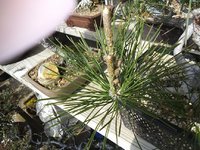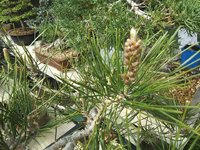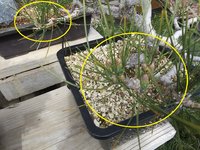You are using an out of date browser. It may not display this or other websites correctly.
You should upgrade or use an alternative browser.
You should upgrade or use an alternative browser.
A few JBP questions.
- Thread starter Mike Corazzi
- Start date
Maiden69
Masterpiece
1. look like cones, but all the cones I had on my JBP so far extend from the tip of the candle.
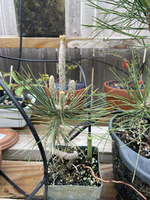
2. Pollen cones
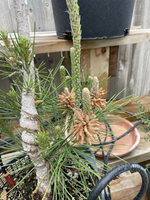
3. This is optional, some people say leave them, some say remove. I learned that if you leave them and they are on a part of the tree you will be keeping they will create a thick knot that may reduce with time, or may not... like the one on the middle trunk below. I am reducing to 2 if I am not decandeling. The main one that continues the trunk and a branch. If they are on a location that I will be removing, and the area below them can benefit from thickening, I will leave them all.
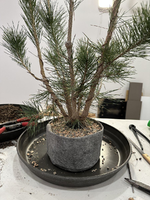

2. Pollen cones

3. This is optional, some people say leave them, some say remove. I learned that if you leave them and they are on a part of the tree you will be keeping they will create a thick knot that may reduce with time, or may not... like the one on the middle trunk below. I am reducing to 2 if I am not decandeling. The main one that continues the trunk and a branch. If they are on a location that I will be removing, and the area below them can benefit from thickening, I will leave them all.

Dabbler
Shohin
- Messages
- 338
- Reaction score
- 502
1- looks like cones - twist them off as they suck up a ton of energy
2 - pollen most likely - again I remove them
3 - This is a tricky question, usually I remove down to two that match the energy of the rest of the tree - you could leave them if those branches need to become stronger, removing them later down to two - kinda need to read the whole tree and what you want to do.
2 - pollen most likely - again I remove them
3 - This is a tricky question, usually I remove down to two that match the energy of the rest of the tree - you could leave them if those branches need to become stronger, removing them later down to two - kinda need to read the whole tree and what you want to do.
Gert
Mame
- Messages
- 174
- Reaction score
- 429
- USDA Zone
- 8b
I reduce to two all over for the sake of allowing light to better access the branches and buds you do want to use. You'll never retain all the buds in a desired design anyway so reduce to two. I have no evidence but from what I've heard as long as you keep the central candle wood production isn't affected that much (if you're trying to grow out). I keep a single candle on sacrifice branches that I grow out.
Brian Van Fleet
Pretty Fly for a Bonsai Guy
Wires_Guy_wires
Imperial Masterpiece
I made that calculation twice: total mass of a single cone with seeds, compared to a branch including foliage. Both in dry weight.1- looks like cones - twist them off as they suck up a ton of energy
In essence, the formation of 1.5 shoots equals one cone.
If we candle cut 20 candles, we take the energy of about 13 cones away from a tree.
From that point of view, the ton of energy isn't that big of a ton.
I invite everyone to correct my point of view and do a better calculation.
My math sucks, so it could be entirely different than what anyone else can come up with. That's why I did it twice.
Dabbler
Shohin
- Messages
- 338
- Reaction score
- 502
I made that calculation twice: total mass of a single cone with seeds, compared to a branch including foliage. Both in dry weight.
In essence, the formation of 1.5 shoots equals one cone.
If we candle cut 20 candles, we take the energy of about 13 cones away from a tree.
From that point of view, the ton of energy isn't that big of a ton.
I invite everyone to correct my point of view and do a better calculation.
My math sucks, so it could be entirely different than what anyone else can come up with. That's why I did it twice.
No one like math...
J/k I don't think it works that way(I have no idea) but I've just always removed them - so the point is moot lol
Mike Corazzi
Masterpiece
Pollen flowers appear at the base of extending candles, ignore them.
The actual pine cones develop at the tip of extending candles like @Maiden69 has.
We have lots of threads that already cover this.
I took off all BUT 2. So it "looks" like his.
Scorpius
Chumono
Depends on what stage you're in with those pines.
Shibui
Imperial Masterpiece
The growths at the base and along developing candles are almost always male pollen cones. I have occasionally had female cones develop from the side of candles but almost always at the tips.
Pollen cones must take some energy to grow and mature but probably insignificant in the scheme of things.
Take them off if you can be bothered. I don't have time so just let them develop and enjoy the clouds of pollen when they release later in spring.
Multiple candles can probably should have been reduced in fall for best affect but anytime will be OK. Appears to be on low branches so probably won't hurt to leave a bit longer. The extra growth might accelerate branch thickening a little. If its' a thicker or higher branch you don't want extra size then get rid of asap.
Pollen cones must take some energy to grow and mature but probably insignificant in the scheme of things.
Take them off if you can be bothered. I don't have time so just let them develop and enjoy the clouds of pollen when they release later in spring.
Multiple candles can probably should have been reduced in fall for best affect but anytime will be OK. Appears to be on low branches so probably won't hurt to leave a bit longer. The extra growth might accelerate branch thickening a little. If its' a thicker or higher branch you don't want extra size then get rid of asap.
shohin_branches
Shohin
It takes more energy to make complex tissue structures like pollen, cones, and seeds than to make branches and needles. Dry weight is not going to tell you much about energy used to create.I made that calculation twice: total mass of a single cone with seeds, compared to a branch including foliage. Both in dry weight.
In essence, the formation of 1.5 shoots equals one cone.
If we candle cut 20 candles, we take the energy of about 13 cones away from a tree.
From that point of view, the ton of energy isn't that big of a ton.
I invite everyone to correct my point of view and do a better calculation.
My math sucks, so it could be entirely different than what anyone else can come up with. That's why I did it twice.
Wires_Guy_wires
Imperial Masterpiece
I don't believe that this is the case. Pollen for instance contains way less proteins and cellular structures than other plant cells, they nees to be lightweight and have just half the DNA of a regular cell. Cones are mainly lignin, seeds have a high protein content but so does foliage.It takes more energy to make complex tissue structures like pollen, cones, and seeds than to make branches and needles. Dry weight is not going to tell you much about energy used to create.
To produce either of those, takes an investment of energy, foliage returns the favor unless we cut it off like we do with JRP and JBP in refinement.
So I'm curious what your reasoning behind your statement is.
shohin_branches
Shohin
You're leaving out all of the carbohydrate energy being used in seed production and necter production in flowers. Flowers and cones/seed structures generally don't photosynthesize efficiently (if they do at all depending on the plant) so they aren't producing more carbohydrates to replenish used energy stores. Flowers are also filled with higher concentrations of anthocyanins to give them color. Creating specialized gametes takes extra energy.I don't believe that this is the case. Pollen for instance contains way less proteins and cellular structures than other plant cells, they nees to be lightweight and have just half the DNA of a regular cell. Cones are mainly lignin, seeds have a high protein content but so does foliage.
To produce either of those, takes an investment of energy, foliage returns the favor unless we cut it off like we do with JRP and JBP in refinement.
So I'm curious what your reasoning behind your statement is.
Carbohydrates are the main energy source for plants. Plants do make and use some protien but it's water soluable carbohydrates that are utilized the most. I learned this in the classroom, my source is my botany and horticulture instructors. We also discuss it a lot in bonsai which is why many trees that are still being developed have flower buds removed so those energy stores can be used to push growth and not produce flowers and seeds.
Wires_Guy_wires
Imperial Masterpiece
We're talking pines here, so flower color and nectar are out of the equation.You're leaving out all of the carbohydrate energy being used in seed production and necter production in flowers. Flowers and cones/seed structures generally don't photosynthesize efficiently (if they do at all depending on the plant) so they aren't producing more carbohydrates to replenish used energy stores. Flowers are also filled with higher concentrations of anthocyanins to give them color. Creating specialized gametes takes extra energy.
Carbohydrates are the main energy source for plants. Plants do make and use some protien but it's water soluable carbohydrates that are utilized the most. I learned this in the classroom, my source is my botany and horticulture instructors. We also discuss it a lot in bonsai which is why many trees that are still being developed have flower buds removed so those energy stores can be used to push growth and not produce flowers and seeds.
Do gametes, with just half of the normal cell contents and just a quarter of the total proteins, require more energy? I don't think they do.
We remove flower buds in plants that do produce nectar, yes. Because nectar is pure carbs.
However, my statement for pine cones stands firm: compared to shoots, which we cut off in JRP and JBP, a cone equals about 1.5 shoots.
So the energy that goes into a cone, or a pine pollen cone, is not a huge investment.
We often treat all plants the same when it comes to energy balancing, but I believe that that's not always correct. Wind pollinators have super lightweight pollen, so those are naturally smaller, lighter and less complex than plants that need pollinators. If the female flower structures are literally made out of wood and don't have to attract pollinators, they're not at all the same when you compare them to more flashy flowers.
I made that statement, and the calculations, not to start an argument, but in hopes to let people realise that it's comparing sea horses with land horses. I was flabbergasted with the outcome because I was under the impression too, that all flowers, seeds and fruits are equal.
When we talk about root pruning and foliage management, those differences are easy to grasp. But it's rather funny that people still think flowers with 20 million years of evolution separating them behave the same.
shohin_branches
Shohin
It doesn't work different for conifer or deciduous trees, wind pollinated or pollinator reliant plants.
Most trees do not flower and fruit until they reach maturity. This is an evolutionary trait to make sure the tree is healthy and established enough to expend energy reproducing without affecting the tree health. In pine nut orchards they graft mature stock onto the branches of young trees to get their trees producing faster. Since they're properly watered and fertilized the tree won't suffer from cone and nut production at an earlier age than a wild tree growing in suboptimal conditions.
You can't measure energy used based off weight though. That doesn't take into account gas echange which means the hypothesis is already flawed. You'll also need foundational knowledge in organic chemistry. Making and breaking bonds in compounds takes different amounts of energy depending on what is happening.
There is no correlation between weight of plant material and the amount of energy the plant uses to create it
Most trees do not flower and fruit until they reach maturity. This is an evolutionary trait to make sure the tree is healthy and established enough to expend energy reproducing without affecting the tree health. In pine nut orchards they graft mature stock onto the branches of young trees to get their trees producing faster. Since they're properly watered and fertilized the tree won't suffer from cone and nut production at an earlier age than a wild tree growing in suboptimal conditions.
You can't measure energy used based off weight though. That doesn't take into account gas echange which means the hypothesis is already flawed. You'll also need foundational knowledge in organic chemistry. Making and breaking bonds in compounds takes different amounts of energy depending on what is happening.
There is no correlation between weight of plant material and the amount of energy the plant uses to create it
Wires_Guy_wires
Imperial Masterpiece
Why not? Lignin, proteins and cells all come from the same materials and all require the same biochemical processes to be built. We know how much ATP photosynthesis produces, we know how much ATP is needed to build wood.You can't measure energy used based off weight though. That doesn't take into account gas echange which means the hypothesis is already flawed. You'll also need foundational knowledge in organic chemistry. Making and breaking bonds in compounds takes different amounts of energy depending on what is happening.
Gas exchange is a mostly passive process, and takes place regardless of what is growing.
If you want to stick to the "you can't correlate output weight to energy input" then the whole argument is nullified in both directions: it defeats the statement that it takes more energy to make sexual structures or nectar, than to make foliage and wood. We simply can't say because we don't know the whole biochemical cascade..
Unless..
If we apply the foundational knowledge we have on how dry weight relates to energy consumption, which is fair considering the cell atlas of plants is still being built and we can't dive much deeper yet, we can in fact relate the two! We know that highly photosynthetic plants produce more mass, because their photosynthesis is more efficient (more energy produced = more mass produced). Because carbon fixation is directly related to photosynthetic activity and protein production seems to be too. If we remove water from the equation, we're left with dry mass.
I know for a fact that studies of plants in the dark have been performed on carbohydrate or acetate rich media that did quantify energy input and plant mass produced.
Either we assume a little of the unknown things, or none at all. We shouldn't do both, depending on our side of the argument.
shohin_branches
Shohin
This has already been studied and published by thousands of botanists. You have to go look up the studies.Why not? Lignin, proteins and cells all come from the same materials and all require the same biochemical processes to be built. We know how much ATP photosynthesis produces, we know how much ATP is needed to build wood.
Gas exchange is a mostly passive process, and takes place regardless of what is growing.
If you want to stick to the "you can't correlate output weight to energy input" then the whole argument is nullified in both directions: it defeats the statement that it takes more energy to make sexual structures or nectar, than to make foliage and wood. We simply can't say because we don't know the whole biochemical cascade..
Unless..
If we apply the foundational knowledge we have on how dry weight relates to energy consumption, which is fair considering the cell atlas of plants is still being built and we can't dive much deeper yet, we can in fact relate the two! We know that highly photosynthetic plants produce more mass, because their photosynthesis is more efficient (more energy produced = more mass produced). Because carbon fixation is directly related to photosynthetic activity and protein production seems to be too. If we remove water from the equation, we're left with dry mass.
I know for a fact that studies of plants in the dark have been performed on carbohydrate or acetate rich media that did quantify energy input and plant mass produced.
Either we assume a little of the unknown things, or none at all. We shouldn't do both, depending on our side of the argument.
Wires_Guy_wires
Imperial Masterpiece
Yes, and I've been repeating some findings. I used to be one of those scientists too and that's why I'm pretty confident in stating that the amount of energy it takes to grow a pine cone, is not a whole lot more than the energy it takes to grow a branch.This has already been studied and published by thousands of botanists. You have to go look up the studies.
The lignin in a branch is no different than the lignin in a pinecone. The proteins in a plant cell in the foliage, is not a whole lot different than in a gamete - I've grown gametes into fully grown plants and did the opposite too. The sugars and starches in seeds are no different than those needed to build a needle. Wind pollinators are extremely efficient at building their flowers, it's why they're so successful.
Those botanists you mention, used the same techniques as I did to estimate things, they've proven that plant mass is related to energy consumption and that this is about the best method we have right now to compare the energy consumption to build secondary structures. You're saying that this is impossible to measure and thus an estimate would not be legitimate in an argument.
I'm saying that this is cherry picking what to believe based on the point of view you're occupying.
Ask those teachers of yours about their opinion on dry mass in relation to energy consumption, they might surprise you.
Similar threads
- Replies
- 5
- Views
- 394

